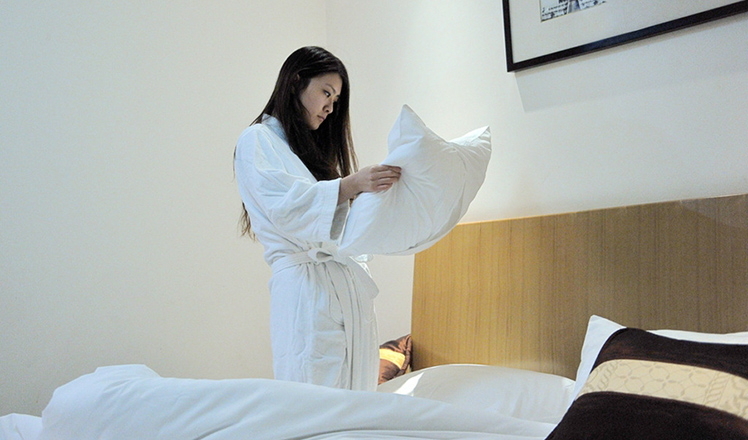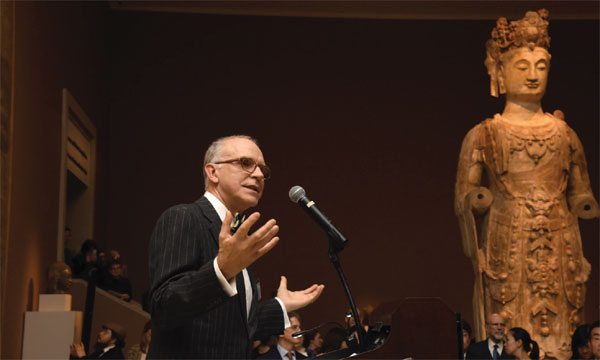Art week undaunted by lower sales
Updated: 2016-03-23 10:51
By Hezi Jiang in New York(China Daily USA)
|
||||||||
Economies will fluctuate, but Chinese art has staying power, according to one gallery owner.
"The long-term future of the Chinese art market is easy to predict," said James Lally, whose New York gallery bears his name. "Chinese art will be more and more collected around the world. It's one of the greatest civilizations of history."
Lally spoke to China Daily on a day when the eighth annual Asia Week New York announced that its art sales had fallen precipitously over the past year. The event concluded on March 19 with $130 million in sales compared with $360 million in 2015.
The organizer of the event painted a rosy picture of some of the sales.
"I was actually pleased because the high-end arts did well," said Lark Mason, Asia Week New York chairman.
Art insiders had been predicting lower sales ahead of the 10-day Asian art "shopping spree". The art market is "very much linked to the economy", said Grace Rong Li, an art adviser, noting China's economic transition and stock market volatility.
Mason said it's the not-so-rich who were most affected.
"The economy in China did not affect the high-end and best-quality items, but it absolutely affected the less-quality, lower-value items," said Mason. Those with less disposable income "are more dramatically affected by the downturn of the Chinese economy than people who are wealthy with lots of resources".
Dessa Goddard, head of Asian Art for the Americas at Bonhams, made a similar observation. Bonhams, a privately owned British auction house, recorded $8.7 million in sales during Asia Week, with the two Chinese art auctions realizing close to $3.6 million.
The top sale was a jade vase and lid from the Qianlong period (1735-96) that soared past estimates and claimed more than $1 million, eight times its high estimate.
"Whereas the lower end and middle market are a bit sluggish, the very best pieces still achieve excellent prices; in my view, an indication that the very wealthy have not been greatly impacted by the current turbulence," she told China Daily in an e-mail. "Perhaps the greatest impact we are seeing is that first-time bidders were down about 50 percent from a year ago."
According to Goddard, snuff bottles continue to be a very popular collectible. Pre-20th-century jade carvings also are selling very well, and there has been great interest in Buddhist works of art.
"Archeological material has picked up somewhat in the last couple of years, but continues to be a soft spot," she said.
Mason described the current buyers as "more sober and more selective".
"In an economic downturn, you lose the speculative buyers who are buying things with the intent of immediately selling them. Those people disappear," he said.
Goddard said Bonhams also saw less exorbitant bids, and "a higher rate of lots selling for closer to their pre-sale estimates".
Lally, who has 46 years of experience in dealing Chinese art, believes the slowdown is quite natural, as many of the Chinese buyers, who are also dealers themselves back in China, gain more arts knowledge.
"They have done a lot more work," he said.
A large number of art dealers from China started in the 1990s and began with a small inventory, Lally said. Like many art dealers, they made a lot of purchases at first.
"There are things that you pay too much for and take longer to sell," he said. "That makes you sober."
There is a learning curve to identify the unique objects that are worth stretching one's bid for, said Lally, and many of the Chinese buyers are making better decisions.
"The Chinese buyers are some of the fastest learners I've seen," he said.
Lally curated a 75-piece ancient Chinese jade exhibition for Asia Week and sold about 80 percent of the collection. Buyers from China purchased about 40 percent of the items, he said.
hezijiang@chinadailyusa.com
|
Lark Mason, chairman of Asia Week New York, speaks at a reception on March 14 at The Metropolitan Museum of Art. Provided to China Daily |
(China Daily USA 03/23/2016 page2)
- Police issue wanted notice for suspect after Brussels attacks
- China eyes cooperation plan for Lancang-Mekong countries
- Toronto's colorful former mayor Rob Ford dies of cancer
- NASA's Kepler sees first 'shock breakout' in exploding star
- First case of Zika virus detected in S.Korea
- Syrian mothers: Survival and loss

 Migrant couple returns to hometown to raise chickens
Migrant couple returns to hometown to raise chickens
 Victims of Brussels attacks commemorated
Victims of Brussels attacks commemorated
 In photos: Brussels rocked by multiple explosions
In photos: Brussels rocked by multiple explosions
 Raul Castro and Obama hold talks in Havana
Raul Castro and Obama hold talks in Havana
 Facebook's Mark Zuckerberg visits China's Great Wall
Facebook's Mark Zuckerberg visits China's Great Wall
 Apple releases smaller iPhones for new consumers
Apple releases smaller iPhones for new consumers
 China's 'sleep testers' search hotels for a good night's rest
China's 'sleep testers' search hotels for a good night's rest
 Practice makes perfect: Preparing for Boao forum
Practice makes perfect: Preparing for Boao forum
Most Viewed
Editor's Picks

|

|

|

|

|

|
Today's Top News
Marriott unlikely to top Anbang offer for Starwood: Observers
Chinese biopharma debuts on Nasdaq
What ends Jeb Bush's White House hopes
Investigation for Nicolas's campaign
Will US-ASEAN meeting be good for region?
Accentuate the positive in Sino-US relations
Dangerous games on peninsula will have no winner
National Art Museum showing 400 puppets in new exhibition
US Weekly

|

|
